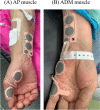A comparison between the adductor pollicis muscle and the abductor digiti minimi muscle using electromyography AF-201P in rocuronium-induced neuromuscular block: a prospective comparative study
- PMID: 35459095
- PMCID: PMC9034586
- DOI: 10.1186/s12871-022-01656-y
A comparison between the adductor pollicis muscle and the abductor digiti minimi muscle using electromyography AF-201P in rocuronium-induced neuromuscular block: a prospective comparative study
Abstract
Background: The AF-201P, a new electromyography (EMG)-based neuromuscular monitor has been developed recently. The aim of this clinical study was to compare two ulnar nerve innervated muscles: the adductor pollicis (AP) muscle and the abductor digiti minimi (ADM) muscle during the recovery from rocuronium-induced neuromuscular block by using EMG AF-201P.
Methods: Twenty patients undergoing surgery with general anesthesia were enrolled in the study. During total intravenous general anesthesia, train-of-four (TOF) and post-tetanic counts (PTC) responses following 0.9 mg/kg rocuronium administration were concurrently monitored at the AP and the ADM muscles with EMG AF-201P on the opposite arms. At the end of the surgery, sugammadex 2 mg/kg was administered when TOF counts of 2 (TOFC2) was observed at both muscles. The primary outcome of the study was time from administration of rocuronium to first appearance of PTC response (first PTC). The secondary outcomes of the study were time from administration of rocuronium to TOF count of 1 (TOFC1), time from first PTC to TOFC1 (PTC-TOF time), time to TOFC2, and time from administration of sugammadex to TOF ratio ≥ 0.9. Agreement between the two muscles was assessed using the Bland-Altman analysis. Data are expressed as mean ± standard deviation.
Results: Nineteen patients were included in the analysis. Time to first PTC was significantly faster at the ADM muscle than the AP muscle (24.4 ± 11.4 min vs 32.4 ± 13.1 min, p = 0.006). PTC-TOF time was significantly longer with the ADM muscle than the AP muscle (19.4 ± 7.3 min vs 12.4 ± 10.6 min, p = 0.019). There were no significant differences in time to TOFC2 and sugammadex-facilitated recovery between the two muscles. Bland-Altman analyses showed acceptable ranges of bias and limits of agreement of the two muscles.
Conclusions: The ADM muscle showed a good agreement with the AP muscle during rocuronium-induced neuromuscular block but faster recovery of PTC response when using EMG.
Trial registration: UMIN-CTR (Registration No. UMIN000044904 ). Registered 19 July 2021 -Retrospectively registered, https://center6.umin.ac.jp/cgi-bin/ctr_e/ctr_view.cgi?recptno=R000051290 .
Keywords: Abductor digiti minimi muscle; Adductor pollicis muscle; Electromyography; Neuromuscular monitoring; Rocuronium; Sugammadex.
© 2022. The Author(s).
Conflict of interest statement
Hajime Iwasaki and Shunichi Takagi have received speaker fees from MSD. Inc, Japan and Nihon-Kohden. Inc, Japan. Osamu Kitajima, and Takahiro Suzuki have received speaker fees from MSD. Inc, Japan. Hanae Sato and Sarah Kyuragi Luthe declare that they have no competing interests.
Figures


Similar articles
-
A Comparison Between the Adductor Pollicis Muscle Using TOF-Watch SX and the Abductor Digiti Minimi Muscle Using TetraGraph in Rocuronium-Induced Neuromuscular Block: A Prospective Observational Study.Anesth Analg. 2022 Aug 1;135(2):370-375. doi: 10.1213/ANE.0000000000005897. Epub 2022 Jan 21. Anesth Analg. 2022. PMID: 35061641
-
Comparison of two electromyography-based neuromuscular monitors, AF-201P and TetraGraph, in rocuronium-induced neuromuscular block: A prospective comparative study.Anaesth Crit Care Pain Med. 2022 Dec;41(6):101145. doi: 10.1016/j.accpm.2022.101145. Epub 2022 Aug 31. Anaesth Crit Care Pain Med. 2022. PMID: 36057386
-
Comparison of a new EMG module, AF-201P, with acceleromyography using the post-tetanic counts during rocuronium-induced deep neuromuscular block: a prospective, multicenter study.J Clin Monit Comput. 2022 Oct;36(5):1347-1353. doi: 10.1007/s10877-021-00768-z. Epub 2021 Oct 19. J Clin Monit Comput. 2022. PMID: 34664189
-
Monitoring of neuromuscular transmission by electromyography during anaesthesia. A comparison with mechanomyography in cat and man.Dan Med Bull. 1996 Sep;43(4):301-16. Dan Med Bull. 1996. PMID: 8884132 Review.
-
The effect of dexamethasone on sugammadex reversal of rocuronium-induced neuromuscular blockade in surgical patients undergoing general anesthesia: A systematic review and meta-analysis.Medicine (Baltimore). 2021 Feb 5;100(5):e23992. doi: 10.1097/MD.0000000000023992. Medicine (Baltimore). 2021. PMID: 33592855 Free PMC article.
Cited by
-
From revival to routine: electromyography-based neuromuscular monitoring in contemporary anesthesia practice.Anesth Pain Med (Seoul). 2025 Jul;20(3):222-229. doi: 10.17085/apm.25267. Epub 2025 Jul 31. Anesth Pain Med (Seoul). 2025. PMID: 40792367 Free PMC article. Review.
-
Pharmacokinetic-Pharmacodynamic Simulation of Muscle Relaxation Antagonistic Conditions for Post-Operative Recurarization Prevention.J Clin Med. 2025 Mar 17;14(6):2043. doi: 10.3390/jcm14062043. J Clin Med. 2025. PMID: 40142851 Free PMC article.
References
-
- Takagi S, Suzuki T, Nakatsuka H, Sasakawa T, Iwasaki H, Kotake Y, Nagata E, Kanmura Y: Comparison of a new EMG module, AF-201P, with acceleromyography using the post-tetanic counts during rocuronium-induced deep neuromuscular block: a prospective, multicenter study. J Clin Monit Comput 2021. 10.1007/s10877-021-00768-z. Online ahead of print. - PubMed
Publication types
MeSH terms
Substances
Associated data
- Actions
LinkOut - more resources
Full Text Sources

